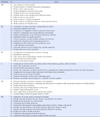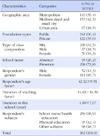Abstract
Purpose
The purpose of this study was to identify the Clusters of health promoting schools in middle and high schools for the Korean Youth Risk Behaviors Web-based Survey.
Methods
The tool of health promoting school was developed based on a framework for action for health promoting schools in World Health Organization and Schools Health Index for middle and high schools in the United States by 2 professionals and 2 health teachers and revised as a result of the preliminary study. Data were collected with a questionnaire from teachers who attended the conference run by Korean Centers for Communicable Disease Control and Prevention in 2009. The data of 363 schools were analyzed using descriptive analysis, t-test, and ANOVA.
Figures and Tables
Figure 1
Mean score of each item in school health policies, physical and social environment of the school.

Figure 2
Mean score of each item in community links, action competencies for healthy living, and school health care and promotion services.

References
1. Centers for Disease Control and Prevention. School Health Index: A self-assessment and planning guide. middle school/high school version. Atlanta, GA: Authors;2005. Retrieved April 20, 2012. from http://www.cdc.gov/healthyyouth/SHI.
2. Coggans N, Mckeller S. Health promoting schools-an investigation into the wider context of health education in schools. Glasgow, Scotland: University of Strathclyde, Hobsons Publishing;1995.
3. Hyman IA, Perone DC. The other side of school violence: Educator policies and practices that may contribute to student misbehavior. J Sch Psychol. 1998; 36(1):7–27. http://dx.doi.org/10.1016/S0022-4405(97)87007-0.
4. Kim YI. A study of the index development and measurement for school health promoting behaviors. J Korean Soc Sch Health. 1998; 11(2):189–201.
5. Kim M. A research on the organizational and improvement method of health education at middle and high school. Changwon: Changwon National University;2009. Unpublished master's thesis.
6. Kim YS, Ha YM, Park HJ, Jung HS, Kwon EH. Survey on current state and strategies for strengthening school health education in elementary middle, and high schools in Seoul. Educ Cult Res. 2011; 17(3):353–374.
7. Korea Center for Disease Control and Prevention. Results of health risk behaviors among Korea adolescents. 2011. Retrieved April 25, 2012. from http://yhs.cdc.go.kr/.
8. Lee A, Cheng FFK, Leger LS. Evaluating health-promoting schools in Hong Kong: Development of a framework. Health Promot Int. 2005; 20(2):177–186. http://dx.doi.org/10.1093/heapro/dah607.

9. Lee A, Cheng FF, Yuen H, Ho M, Lo A, Fung Y, et al. Achieving good standards in health promoting schools: Preliminary analysis one year after the implementation of the Hong Kong healthy schools award scheme. Public Health. 2007; 121(10):752–760. http://dx.doi.org/10.1016/j.puhe.2007.01.014.

10. Lee A, Wong MC, Keung VM, Yuen HS, Cheng F, Mok JS. Can the concept of health promoting schools help to improve students' health knowledge and practices to combat the challenge of communicable disease: Case study in Hong Kong? BMC Public Health. 2008; 8:42. http://dx.doi.org/10.1186/1471-2458-8-42.

11. Lee CY, Chung YS, Han JH, Lee CO, Kwon IS. Development and performance analysis of elementary school health promotion policy guideline. J Korean Community Nurs. 2003; 14(3):457–467.
12. Lee EY, Choi BY, Sohn AR, Ahn DH. Evaluation of health promoting school by school characteristics. J Korean Soc Health Educ Promot. 2009; 26(3):85–96.
13. Lee MS, Park KO. School safety education factors predicting injury prevalence among Korean adolescence. J Korean Soc Health Educ Promot. 2004; 21(2):147–165.
14. Lee EY, Park KO, Shin Y, Choi BY. Implementation status of related factors of health promoting schools among elementary, middle and high schools: Based on the WHO guidelines. Korean J Health Educ Promot. 2012; 29(1):109–120.
15. St Leger L. Australian teachers' understandings of the health promoting school concept and the implications for the development of school health. Health Promot Int. 1998; 13(3):223–235. http://dx.doi.org/10.1093/heapro/13.3.223.
16. Lavin AT, Shapiro GR, Weill KS. Creating an agenda for school-based health promotion: A review of 25 selected reports. J Sch Health. 1992; 62(6):212–228. http://dx.doi.org/10.1111/j.1746-1561.1992.tb01231.x.

17. McGue M, Lacono WG, Krueger R. The association of early adolescent problem behavior and adult psychopathology: A multivariate behavioral genetic perspectives. Behav Genet. 2006; 36(4):591–602. http://dx.doi.org/10.1007/s10519-006-9061-z.
18. Ministry of Education, Science and Technology. Operation plan of project for models of health promoting schools. 2012. 04. Retrieved January 11, 2013. from https://schoolhealth.kedi.re.kr/LuBoard/SHealth/SHDataBbsView.php?LstNum1=1441&PageNum=4&GbnCode=0101.
19. Moon A. Health promoting schools and healthy schools awards. Promot Educ. 2002; Suppl 1. 25–28. http://dx.doi.org/10.1177/10253823020090010113.

20. Nutbeam D. Health literacy as a public health goal: A challenge for contemporary health education and communication strategies into the 21st century. Health Promot Int. 2000; 15(3):259–267. http://dx.doi.org/10.1093/heapro/15.3.259.

21. Park YS, Kim U. Psychological, behavioral, and relational characteristics of school violence: Comparative analysis of victims, bullies, non-participants of aggression. Korean J Psychol Soc Issues. 2001; 7(1):63–89.
22. Rogers E, Moon AM, Mullee MA, Speller VM, Roderick PJ. Developing the 'health-promoting school'-a national survey of healthy school awards. Public Health. 1998; 112(1):37–40. http://dx.doi.org/10.1038/sj.ph.1900418.
23. Rowe F, Stewart D, Patterson C. Promoting school connectedness through whole school approaches. Health Educ. 2007; 107(6):524–542. http://dx.doi.org/10.1108/09654280710827920.

24. Sohn A, Kim B, Kim SH, Shin YJ, Ahn D, Choi BY. Evaluating health-promoting schools based on WHO standards in Yangpyung-gun, Korea. J Korean Soc Sch Health Educ. 2008; 9(1):1–15.
25. Statistics Korea. Causes of death. 2011. Retrieved May 3, 2012. from http://kostat.go.kr.
26. World Health Organization. The Ottawa charter for health promotion. Ottawa, Canada: WHO Regional Office;1986.
27. World Health Organization. Health promoting schools: A framework for action. Manila, Philippines: World Health Organization Western Pacific Region;2009.
28. Shi-Chang X, Zhang X, Xu S, Tang S, Yu S, Carmen A, et al. Creating health-promoting schools in China with a focus on nutrition. Health Promot Int. 2004; 19(4):409–418. http://dx.doi.org/10.1093/heapro/dah402.

29. Xu L, Pan B, Lin J, Chen L, Yu S, Jack J. Creating health-promoting schools in rural China: A project started from deworming. Health Promot Int. 2000; 15(3):197–206. http://dx.doi.org/10.1093/heapro/15.3.197.
30. Xin-Wei Z, Liu L, Zhang X, Guo J, Pan X, Carmen A, et al. Health-promoting school development in Zhejiang Province, China. Health Promot Int. 2008; 23(3):220–230. http://dx.doi.org/10.1093/heapro/dan021.





 PDF
PDF ePub
ePub Citation
Citation Print
Print






 XML Download
XML Download